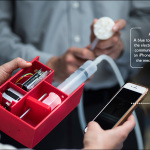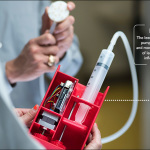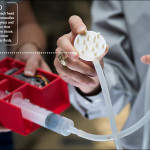 Have you ever swam in a lake or trudged through swampy waters? If so, you probably have encountered leeches during your outdoor adventures. These worms have been used in human medicine for centuries because of their anesthetic, anti-inflammatory and tissue healing properties.
Have you ever swam in a lake or trudged through swampy waters? If so, you probably have encountered leeches during your outdoor adventures. These worms have been used in human medicine for centuries because of their anesthetic, anti-inflammatory and tissue healing properties.
Primarily used in plastic surgery to restore blood flow to reattached body parts, leeches are considered natural healers. While removing deoxygenated blood from damaged tissue, their saliva contains hirudin, an anti-blood clotting protein, that allows oxygenated blood to flow to the injured tissue until normal circulation can be restored.
While leech therapy has never been used in gynecology and is rarely used in pediatrics due to the psychological impact it may have on patients and parents, what if there was a way to develop a mechanical device that could perform the same functions as a traditional leech?
Dr. Julie Hakim, a pediatric and adolescent gynecology fellow at Texas Children’s and Baylor College of Medicine, proposed this idea to a group of biomedical engineering students at Texas A&M University (TAMU) who then developed a mechanical leech prototype for potential use in pediatric gynecological surgeries.
“In pediatric gynecology, we often perform vaginal reconstructive surgery for girls who are born with congenital abnormalities,” Hakim said. “A graft of tissue is taken from somewhere else on the patient’s body to line the new vaginal tract. However, there are times when the grafts fail or do not take because of poor blood circulation to that area. Developing a novel mechanism to promote graft and tissue flap survival by increasing neovascularization of the tissue would help in these type of surgeries.”
With support from the Denton Cooley Innovation Award, the mechanical leech project and design requirements were presented to TAMU students on their first day of Senior Design Course. Two teams totaling eight students met every week with Hakim via Skype to provide updates on their progress. They also met with Dr. Jennifer Dietrich, Texas Children’s chief of Pediatric and Adolescent Gynecology, to present their updates once per semester.
The head of the mechanical leech was created with a small, flat circular unit measuring 1×1 cm fitted with an array of microneedles underneath for leech saliva egress and blood extraction that interfaces with the tissue. The head contains an outer reservoir for leech saliva and an inner reservoir that collects the extracted blood.
The leech body contains pumps that control and monitor the outflow of leech saliva and the inflow of blood, saliva and blood reservoirs. A blue tooth chip inside the pumps’ electronic assembly communicates through an iPhone app that runs the mechanical leech. The motor’s speed and the flow rate of the fluids can be recorded in real time and adjusted remotely via the iPhone app. The outer shell of the leech body and the gear mechanisms are connected by standard medical tubing.
“The mechanical leech has the potential to reduce complications associated with the use of live leeches,” Hakim said. “Since uncontrolled amounts of leech saliva can cause prolonged bleeding, controlling how much leech saliva is placed into the tissue can reduce the risk of transfusion. This mechanical novel device can also help reduce infection since live leeches are known to harbor bacteria.”
The mechanical leech head and the outer shell of the leech body and the gear mechanisms were 3-D printed. The project’s next step is to refine and test the feasibility of the prototype.
“I think this innovation could be of tremendous importance to the field of pediatric gynecology as well as pediatric surgery in general,” Dietrich said. “I’m excited to see where the next phase of this project takes us as we explore new avenues for improving the care we provide to our patients.”




